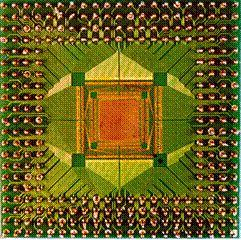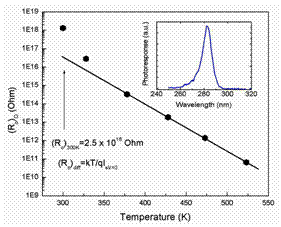Solar-Blind Photodetectors Based on AlGaN
S. Nikishin and H. Temkin
Solid state detectors operating in the ultraviolet have a number of unique applications in astronomy, spectroscopy, and defense. In the spectral range of 240 to 280 nm, solar radiation background is virtually eliminated by the ozone layer absorption. In this spectral region, detector operation is thus not limited by background radiation. Spectral response of AlGaN photodetectors can be easily tuned by adjusting the alloy bandgap and detectors covering the range of 240-360 nm have been prepared. Performance of AlGaN detectors depends on both the device type and perfection of the epitaxial layers. Schottky barrier photodetectors are relatively simple to grow and fabricate. We use n-type AlGaN to prepare individual detectors and their arrays. The leakage current of these devices is reduced by the SiO 2 encapsulation to ~ 10 E-7 A/cm^2 level.

A 128 x 128 array of GaN Schottky photodiodes for use in ultraviolet astronomy.
Leakage current in state-of-the-art double heterostructure photodiodes are now so low that measurements need to be carried at elevated temperatures and room temperature zero-bias resistance (R o) is obtained by extrapolation. For 50 mm diameter diodes this procedure yields R o ~ 2.5 ´ 10 16 W. The corresponding leakage current represents ~ 10 3 electrons/sec. In detectors with peak responsivity at 280 nm the product of R o and the diode area (A), a common figure of merit, reaches R oA ~ 6.1 ´ 10 16 W·cm 2. This results in thermal noise limited specific detectivity D* ~ 3.8 ´ 10 14 cm·Hz 1/2. Performance of these detectors is thus comparable to that of deep UV photomultipliers.
We have recently prepared heterostructure detectors based on digital alloys (short period superlattices). These devices exhibit excellent electrical characteristics, similar those of conventional detectors, but with greatly sub-bandgap response roll-off, making them truly solar-blind.
Research support: DARPA
 Zero-bias resistance Ro of an AlGaN heterostructure detector measured as a function
of temperature. Spectral response is shown in the inset.
Zero-bias resistance Ro of an AlGaN heterostructure detector measured as a function
of temperature. Spectral response is shown in the inset.Nano Tech Center
-
Address
Texas Tech University | Whitacre College of Engineering -
Phone
806.742.3533 -
Email
webmaster.coe@ttu.edu
